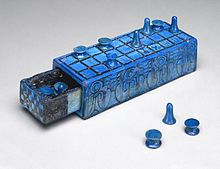Our website is made possible by displaying online advertisements to our visitors.
Please consider supporting us by disabling your ad blocker.
Portal:Games
The Games Portal

A game is a structured type of play, usually undertaken for entertainment or fun, and sometimes used as an educational tool. Many games are also considered to be work (such as professional players of spectator sports or games) or art (such as jigsaw puzzles or games involving an artistic layout such as mahjong, solitaire, or some video games).
Games have a wide range of occasions, reflecting both the generality of its concept and the variety of its play. Games are sometimes played purely for enjoyment, sometimes for achievement or reward as well. They can be played alone, in teams, or online; by amateurs or by professionals. The players may have an audience of non-players, such as when people are entertained by watching a chess championship. On the other hand, players in a game may constitute their own audience as they take their turn to play. Often, part of the entertainment for children playing a game is deciding who is part of their audience and who participates as a player. A toy and a game are not the same. Toys generally allow for unrestricted play, whereas games present rules for the player to follow.
Key components of games are goals, rules, challenge, and interaction. Games generally involve mental or physical stimulation, and often both. Many games help develop practical skills, serve as a form of exercise, or otherwise perform an educational, simulational, or psychological role. (Full article...)
Selected article -
Tafl games (pronounced [tavl]), also known as hnefatafl games, are a family of ancient Northern European strategy board games played on a checkered or latticed gameboard with two armies of uneven numbers. Names of different variants of tafl include hnefatafl, tablut, tawlbwrdd, brandubh, Ard Rí, and alea evangelii. Games in the tafl family were played in Norway, Sweden, Denmark, Iceland, Britain, Ireland, and Sápmi. Tafl gaming was eventually supplanted by chess in the 12th century, but the tafl variant of the Sámi people, tablut, was in play until at least the 18th century. The rules for tablut were written down by the Swedish naturalist Linnaeus in 1732, and these were translated from Latin to English in 1811. All modern tafl games are based on the 1811 translation, which had many errors. New rules were added to amend the issues resulting from these errors, leading to the creation of a modern family of tafl games. In addition, tablut is now also played in accordance with its original rules, which have been retranslated. (Full article...)
Did you know? -
- ...that in 1967, Mac Hack became the first computer chess program to defeat a person in tournament play?
- ...that a reviewer called the narrator in the game Defenders of Ardania (pictured) "booze-obsessed", with a voice that sounds like "a Dalek doing an impression of Sean Connery"?
- ...that snooker player Stephen Maguire won his first ranking tournament at the 2004 European Open in Malta?
- ...that the Crawford-Gilpin House is alleged to have once changed owners due to being lost as a wager in a poker game?
- ...that The Big Bang Theory episode "The Santa Simulation" features a Christmas-themed Dungeons & Dragons game?
General images
Subcategories
Related portals
WikiProjects
Things to do
Selected picture

A screenshot of the physics-based puzzle video game Incredipede showing a level in play
Associated Wikimedia
The following Wikimedia Foundation sister projects provide more on this subject:
-
Commons
Free media repository -
Wikibooks
Free textbooks and manuals -
Wikidata
Free knowledge base -
Wikinews
Free-content news -
Wikiquote
Collection of quotations -
Wikisource
Free-content library -
Wikiversity
Free learning tools -
Wiktionary
Dictionary and thesaurus
Previous Page Next Page






















































